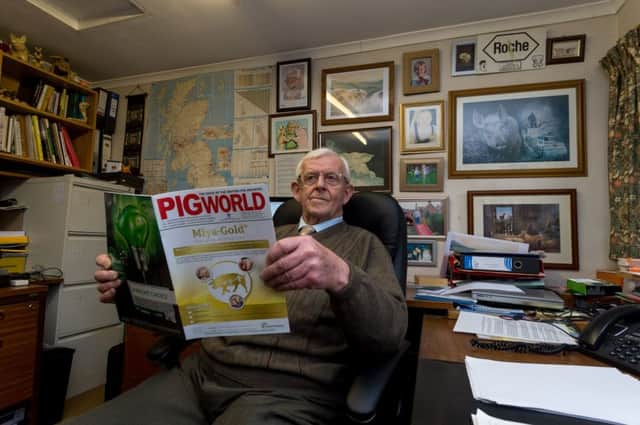Sam Walton has always found the '˜write' way forward in world of pigs


One man who has always succeeded in making people smile in this livestock sector no matter what it has suffered is Sam Walton of Village Farm, Lockington. Sam had pigs himself but is best known for his 25-year tenure as editor of the magazine Pig World that talked serious but didn’t take itself too seriously. The ribald comic strip Moonlight & Daisy featuring a pig and a voluptuous young woman who contrived to lose clothing and bare her assets in each issue may well be frowned upon today but it was also an indication that Sam wanted to provide entertainment as well as promoting the latest ideas.
He has seen the changes made in pig breeding, feeding, housing and the way the market has moved, and he believes that on the whole the sector has improved and continues to lead the way in breeding.
Advertisement
Hide AdAdvertisement
Hide Ad“There was a time when if I drove from my farm to Spurn Point I would pass something like 100 pig breeding units. Today on the same journey there will be a handful, but that doesn’t mean there are no pigs around. There are a lot of B&B pig farmers now. This has been the largest growth sector in our industry and allows specialist breeders to concentrate on their primary role while having pigs finished on a variety of farms which include former pig farms, arable farms that have never had pigs previously and it has brought about erection of new, purpose-built, specialist finishing units.
“Bed and breakfasting pigs has many positives including the reduction of contamination risk as it means you’re not mixing pigs continually. Batches stay together and once they are gone the whole place is cleaned out and you start again.
“The UK and particularly Yorkshire has led the way in pig breeding and production. JSR at Southburn near Driffield has long been a company at the forefront both here and abroad. John Rymer who set up JSR had a great influence and the current JSR gilt 9T gives a lot of pigs while the 900 has fantastic traits.
“The UK had one million sows 25 years ago, there are now under half of that but because of the emphasis on breeding there will probably be just as many pigs. The use of AI has transformed the industry and we now supply breeding stock to what seems like nearly every country in the world.”
Advertisement
Hide AdAdvertisement
Hide AdSam’s route to becoming better known as a pig sector writer than as a farmer was jump-started by another pig industry professional following a farming career that saw him work on a variety of farms in East Yorkshire and Lincolnshire.
“I was born in South Shields and moved to East Yorkshire when I was 11 in 1946. My mother became housekeeper for farmer and auctioneer Philip Leonard at Bewick Hall in Aldbrough where I also worked for a year before attending Askham Bryan Institute in 1952-53.
“I worked on a farm at Acklam for a year and followed that with three years at Maurice Tibbetts’ farm back in Aldbrough where he had 50 sows before being selected for an exchange visit to what was then Southern Rhodesia, now Zimbabwe. That was an unbelievable experience. When I came back I spent seven years with local farmer and auctioneer Eric Wright at Flinton again working with 50 sows before taking up a position on an 850-acre farm in Lincolnshire. It was a most interesting farm that included dairy, arable, daffodils, potatoes, growing blackcurrants for Ribena and was one of the first farms to have oilseed rape as a crop. It was the only farm I ever worked where there were no pigs. I was there five years.”
Sam returned to Yorkshire to take a farm manager’s position at the Watson Hall Estate near Beverley that included four 250-acre farms around Molescroft and Hull Bridge. “I hadn’t been interested when I’d first been approached but having spent a whole day there I was offered the job on three times what I was earning on the other side of the Humber. It had arable cropping, a pedigree Jersey dairy herd and a pedigree Large White herd of pigs. The boss nearly had a fit when I bought a Landrace boar to cross them but when I started selling crossbred gilts he was fine. I was there four years until Village Farm came on the market and Ellen and I moved here in 1973. It was 100 acres at the start and at one time we got up to 220 acres but it’s now 170 acres. We had up to 200 sows but came out of pigs in 1996. It’s all arable now and we contract it out.
Advertisement
Hide AdAdvertisement
Hide Ad“It’s all my friend Bernard Hogarth’s fault that I started Pig World. I’d started writing for a publication called English Farmer and Bernard said that instead of messing about with an arable magazine why not start one for pigs and make it positive, interesting and if at all possible amusing but on no account make it dull and boring.”
The first edition came out in June 1987 and Sam was editor until it was sold in 2012.